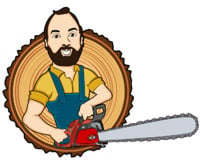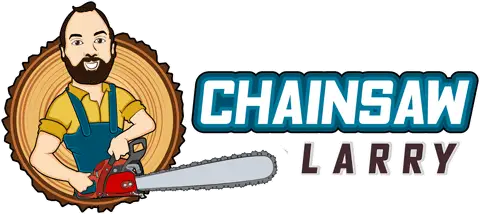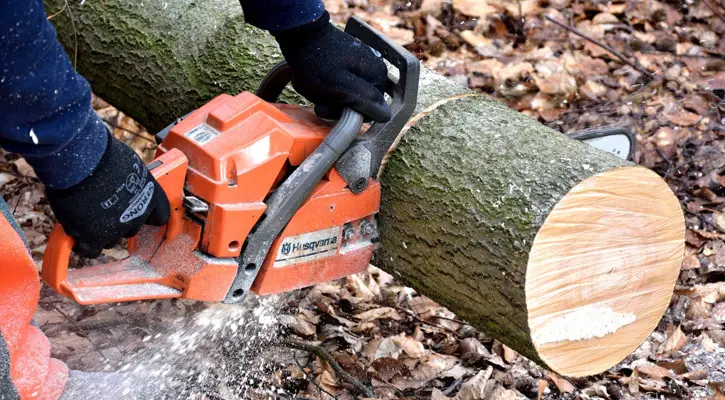Table of Contents
Like with any new tool, there’s a sudden rush of excitement you feel the day you get your new chainsaw.
And you can’t wait to take it out of the box and start using it.
But, before you go firing that bad boy up and hacking away at everything in sight, there are a few rules you need to follow for how to use a chainsaw safely.
Neglecting to take these proper steps could result in some serious injuries—to yourself or others.
So, to make sure you know exactly what you’re doing, I’ll give you the rundown of safe chainsaw operation, including the right equipment for protection, starting procedures, and cutting tips.
But first…
If you don’t own a chainsaw yet, and you’re reading this guide just to get a good idea of how to operate one before you buy it, I invite you to check out my top battery chainsaw reviews.
Battery chainsaws offer quite a few advantages over gas chainsaws and you may just find that they’re the perfect fit.
If you’re interested in finding the best chainsaws for firewood, I also have a dedicated guide on that topic.
And finally, my top chainsaws list includes the best chainsaws available today in gas, battery, and corded electric models.
So, give those pages a look.
#1 Safety First (Protective Clothing)
Did you know that there are around 36,000 chainsaw accidents that require a visit to the hospital each year?
While most of those are true accidents, a number of them could have been prevented if the operator was wearing the right type of gear.
You may have seen lumberjacks in the movies cutting down trees in a pair of jeans without a shirt on, but that’s not something you should ever do.
Safety should be your number one priority every time you use your chainsaw. And to do that, you need to start with the right protective clothing.
A good set of gear to own includes:
- Hard hat or chainsaw helmet
- Slip-resistant and cut-protection gloves
- Eye-protective goggles (or a helmet that includes a face protector)
- Cut-retardant or steel toe boots
- Chaps with at least five layers of cut-retardant material
If you need help finding good choices for these items, you can visit my page on chainsaw safety equipment recommendations.
#2 Grab a Buddy or Have One Ready to Call
When you’re using a chainsaw, it’s best to have someone with you. That way, if an injury does occur, then you’ll have someone who can help.
However, if you are cutting alone, make sure to bring a mobile phone with you that gets good reception. And, set up a point of contact ahead of time that you can call if something bad does happen.
The worst-case scenario is that you can’t drive yourself to the hospital. And if that occurs, your buddy can either take you or get help.
If you do have a buddy come with you (or others are around), keep at least 2 tree lengths (150 feet) between you and the bystanders when felling a tree and at least 30 feet when removing limbs or cutting a felled tree.
#3 Survey the Area and The Wood You’re Going to Cut
It’s always important to take a good look around the spot you’re going to be cutting to make sure there’s nothing there that could potentially cause problems.
Check for things like dangling trees, hidden electrical cables, foot obstructions, wildlife, etc. that may cause issues while you’re cutting.
Also check the wood itself for any nails, screws, or other metal objects that may have been inserted without your knowledge. You never want to cut through those types of things with your chainsaw.
#4 Always Cut Below Waist Level
You may be tempted to hack away at tree branches that are above your head or climb a ladder to the reach you need.
But, never do those things when operating a chainsaw. This risk of injury is not worth it.
The safest way to use a chainsaw is at waist level or below. This gives you the best control over the tool.
#5 Prepping Your Chainsaw
Chain Tension
Check the chain tension. Make sure it’s not slipping off the guide bar or is too tight. If either is the case, adjust it.
Power Source
If you’re using a 2-cycle gas chainsaw, make sure it’s filled with the proper oil to gas ratio of mix. Either 40:1 or 50:1 per the manufacturer’s instructions.
If you’re using a battery chainsaw, make sure the batteries are fully charged.
If you’re using a corded electric chainsaw, make sure it’s plugged into a power outlet.
Bar and Chain Oil
Make sure that the bar and chain oil reservoir is filled. If you have a Manual Oiler, give it a few pumps to lubricate the chain. If you have an Automatic Oiler, you don’t have to touch a thing.
#6 Starting the Chainsaw
For Gas Chainsaws
- Place the chainsaw on level ground.
- Put your right foot through the rear handle and step down on it to keep the chainsaw steady.
- Place your left hand on the top handlebar and grip it tight.
- Use your right hand to engage the chain brake so the chain doesn’t spin.
- Turn the on/off switch to the “on” position.
- Open the choke.
- If your chainsaw has a fuel primer, press it several times until fuel can be seen in the bulb.
- Using your right hand, pull up fast on the starter cord.
- When the engine begins to turn over, push the choke back in halfway and pull up on the starter cord again.
- As soon as the engine starts, squeeze the throttle a few times quickly to rev up the engine’s idle.
- Adjust the choke to the run position.
- Once you’re ready to start cutting, release the chain brake.
For Battery Powered and Electric Chainsaws
- Press and hold the safety lock button to make the switch trigger operational.
- Press and hold the trigger switch to start the chainsaw.
- Keep the trigger pressed for continued operation.
#7 Using Your Chainsaw
When using a chainsaw, you always want to stand to the left of the powerhead no matter if you’re limbing, bucking, or felling.
- Limbing is removing branches from a tree.
- Bucking is cutting a downed and delimbed tree into logs.
- Felling is cutting an upright tree so it falls down.
#8 Chainsaw Safety Tips
- Never take your eyes off of the chain when you’re cutting.
- Never cut with the tip of the chainsaw. This can cause a kickback of the blade and may strike your face or body.
- Cut branches as close to the base of the blade as possible.
- Always watch the wood as you’re cutting. If you see the cut start to pinch the chain, stop cutting and rotate around the wood or rotate the wood itself. A pinched chain can cause kickback.
- Never let the chainsaw chain touch the ground or hit dirt while you’re sawing. If you do, it will dull the chain and then it won’t cut very well.
- If you’re bucking a tree and your chainsaw has Bucking Spikes, use them. Bucking Spikes are metal teeth at the base of the guide bar that let you dig into the wood. This gives you a solid pivot point so you can get a cleaner cut.
- Always use two hands to hold the chainsaw. Never cut one-handed.
- Never climb a tree with a chainsaw or cut from a ladder. Buy a pole saw if you need to cut branches that require climbing.
Well, that about covers it on how to use a chainsaw safely.
I hope you enjoyed these tips on how to use a chainsaw properly and ways to keep yourself (and others) safe.
As a reminder, if you’re in the market for a new chainsaw, don’t forget to check out my top battery chainsaw reviews, top chainsaws list, and the best chainsaws for firewood.
I’m sure you’ll find the perfect tool for your needs on one of those pages.
Happy sawing.

Your pal,
Chainsaw Larry


